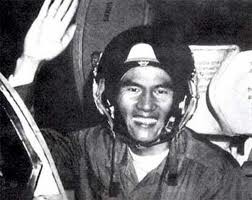(VOVworld) - In the history of the Vietnamese Air Force, heroic pilot Pham Tuan grabbed two records by shooting down an American B52 bomber in 1972 and becoming the 1st Asian cosmonaut to fly into space. Pham Tuan was formerly the Deputy Commander of the Vietnamese Air Force and has received numerous distinctions for his service including Hero of the People’s Armed Forces, Labor Hero, and Hero of the Soviet Union. When talking about the Hanoi-Dien Bien Phu in the air victory, he attributes the victory to the creativeness and bravery of Vietnamese soldiers and people, including himself.
Now a well-known general in Vietnam, Pham Tuan still vividly remembers the day he joined the army. In July, 1965, he and thousands of other young villagers in Kien Xuong district, Thai Binh province, eagerly signed up for the army. Tuan was assigned to the air force, but he failed the test to become a pilot and was sent to study radar technology in Russia. The Russian military recruited pilots from radar technicians, and Tuan was finally able to realize his dream to fly. Tuan recalls: "I was born in the countryside of Thai Binh province. When I was small, I always dreamed of flying. When the war broke out, I joined the army. And my career started."
Graduating from Russia’s military pilot school, Tuan returned to Vietnam in 1967 to become a combat officer of the Red Start Air Force Regiment in the northern region. Tuan and his comrades were assigned to counter the American B52 air strike in 1972. During the 12 day and night air strike, the US sent 741 B52 bombers to drop over 20,000 tons of bombs on Hanoi and Hai Phong. Vietnamese soldiers and Hanoi militias shot down 81 warplanes, including 34 B52 Stratofortress bombers. The B52s flew in formation backed by F111A fighters and interceptors to generate noise to confuse radar. Prior to the Hanoi air strike, the US Air Force had focused on destroying airports where Vietnamese MIC jetfighters could take off. Vietnam secretly moved its jet fighters to the outskirts and took advantage of makeshift airfields on farms to land and take off. On December 18, 1972, Pham Tuan and his comrades received the order to fly. Colonel Vu Van Chuyen navigated for Pham Tuan on that night mission. "Two good pilots, Dinh Ton and Pham Tuan, were assigned to fly. Pham Tuan was a young pilot but skillful, intelligent, and brave. On the night of December 18, although he did not shoot down any B52s, I think he deserved to be called a hero. Amidst a harrowing bombardment, he dared to take off and flew fearlessly to break the adversary’s formation."
 |
On December 27 Pham Tuan flew a MIC 21 through a screen of escort fighters to shoot down a B52 and return to base safely. Lieutenant general Pham Tuan says the victory is still fresh in his mind. "When B52 warplanes flew to the Lao – Vietnam border, some hundreds of kms from Hanoi, I received the sortie order. I might have been the first pilot to spot them on the outskirts of Hanoi. On December 27, I shot down a B52 in Hanoi’s skies. It was a proud moment, which boosted our fighting spirit."
US and international media were surprised by the result and could not understand how a country with poor military facilities could shoot down an inviolable B52 Stratofortress. The next day, the US was stunned by the news that another B52 was destroyed when pilot Vu Xuan Thieu fired two rockets and rushed his fighter toward it.
Pham Tuan later became the first Asian cosmonaut to fly into space, along with Soviet cosmonaut Viktor Gorbatko in July, 1980. At the age of 65, Pham Tuan was demobilized. He said, “Now I’ve really landed. My motto is whatever we do, we should love it and pursue it to the end of the path.”